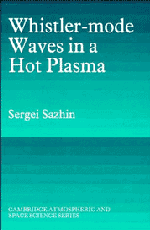Book contents
- Frontmatter
- Contents
- Acknowledgements
- Introduction
- 1 Basic equations
- 2 Propagation in a cold plasma
- 3 Parallel propagation (weakly relativistic approximation)
- 4 Parallel propagation (non-relativistic approximation)
- 5 Quasi-longitudinal approximation
- 6 Quasi-electrostatic approximation
- 7 Growth and damping of the waves
- 8 Non-linear effects
- 9 Applications to the Earth's magnetosphere
- References
- Solutions to the problems
- Index
9 - Applications to the Earth's magnetosphere
Published online by Cambridge University Press: 30 October 2009
- Frontmatter
- Contents
- Acknowledgements
- Introduction
- 1 Basic equations
- 2 Propagation in a cold plasma
- 3 Parallel propagation (weakly relativistic approximation)
- 4 Parallel propagation (non-relativistic approximation)
- 5 Quasi-longitudinal approximation
- 6 Quasi-electrostatic approximation
- 7 Growth and damping of the waves
- 8 Non-linear effects
- 9 Applications to the Earth's magnetosphere
- References
- Solutions to the problems
- Index
Summary
As mentioned in the Introduction, interest in the theory of whistler-mode waves was stimulated mainly by the observations of these waves at groundbased stations and in the Earth's magnetosphere, their applications to the diagnostics of magnetospheric parameters and their role in the balance of the electron radiation belts. An overview (even a brief one) of theoretical models of all manifestations of whistler-mode waves in the magnetosphere is obviously beyond the scope of this book (it would require writing a separate monograph) and we will restrict ourselves to illustrating the application of the theoretical analysis developed in the previous chapters to interpreting only three particular phenomena. In Section 9.1 we consider the problem of the diagnostics of magnetospheric parameters with the help of whistlers generated by lightning discharges. Theoretical models of natural whistler-mode radio emissions observed in the vicinity of the magnetopause are discussed in Section 9.2. In Section 9.3 we apply one of the quasi-linear models described in Chapter 8 to the interpretation of mid-latitude hiss-type emissions observed in the inner magnetosphere. The approaches developed for these three illustrative examples can be extended with some modifications to several other related whistler-mode phenomena. These will be discussed in the appropriate sections.
Whistler diagnostics of magnetospheric parameters
Dynamic spectra of whistlers generated by lightning discharges are shown at the beginning of the book in Fig. I.
- Type
- Chapter
- Information
- Whistler-mode Waves in a Hot Plasma , pp. 210 - 235Publisher: Cambridge University PressPrint publication year: 1993



